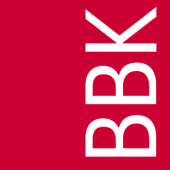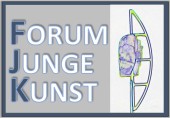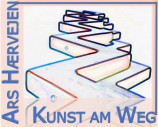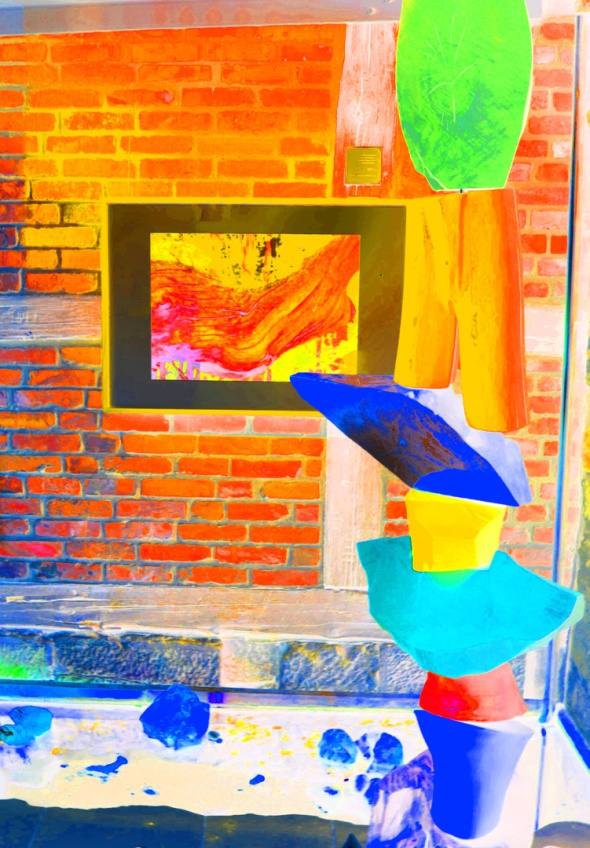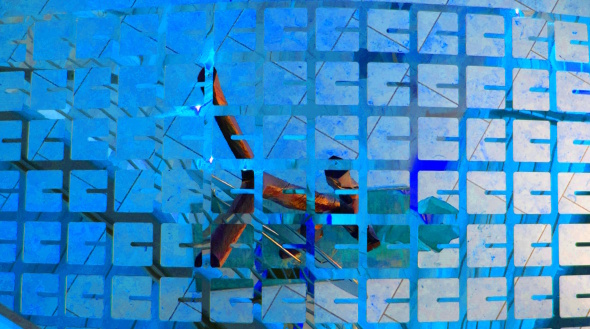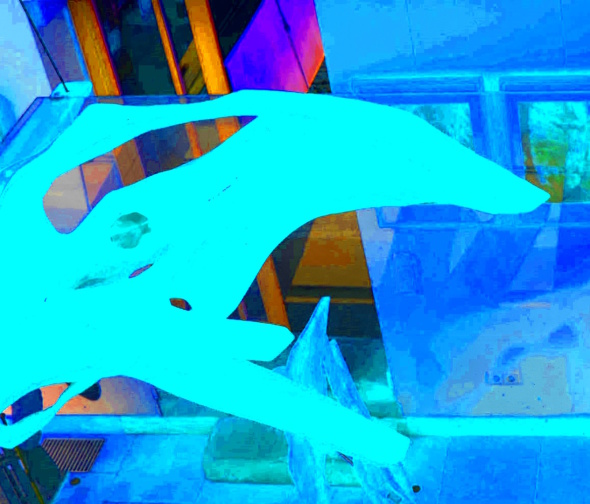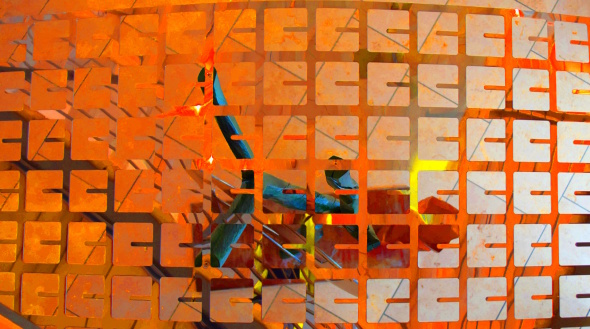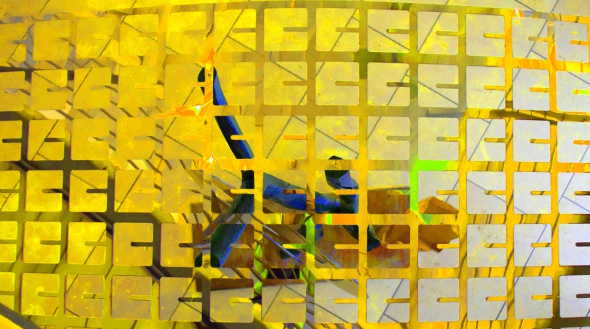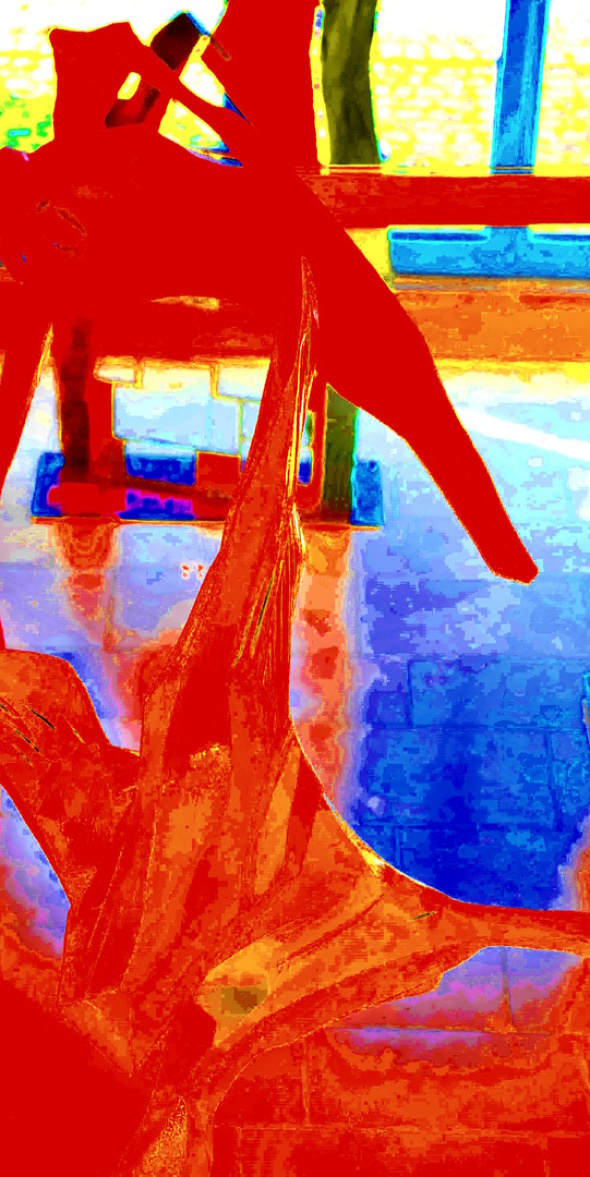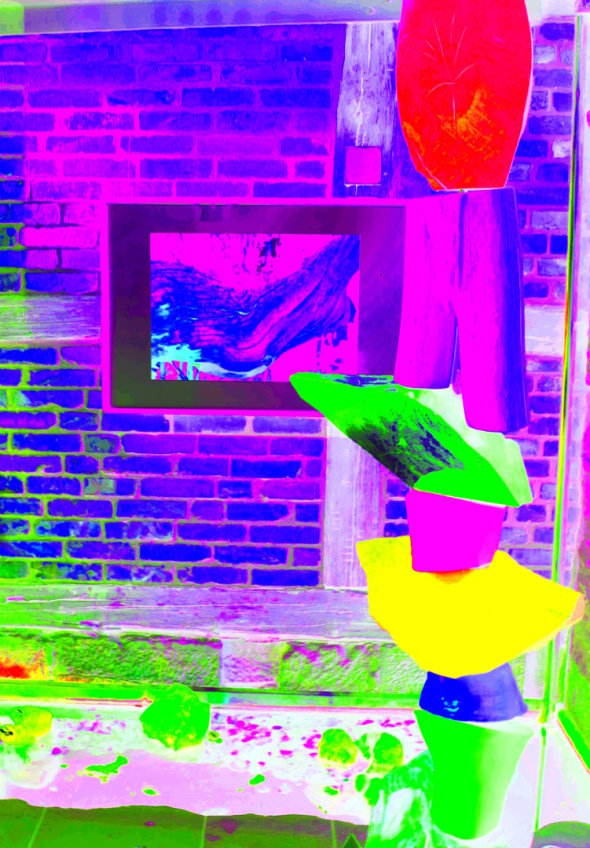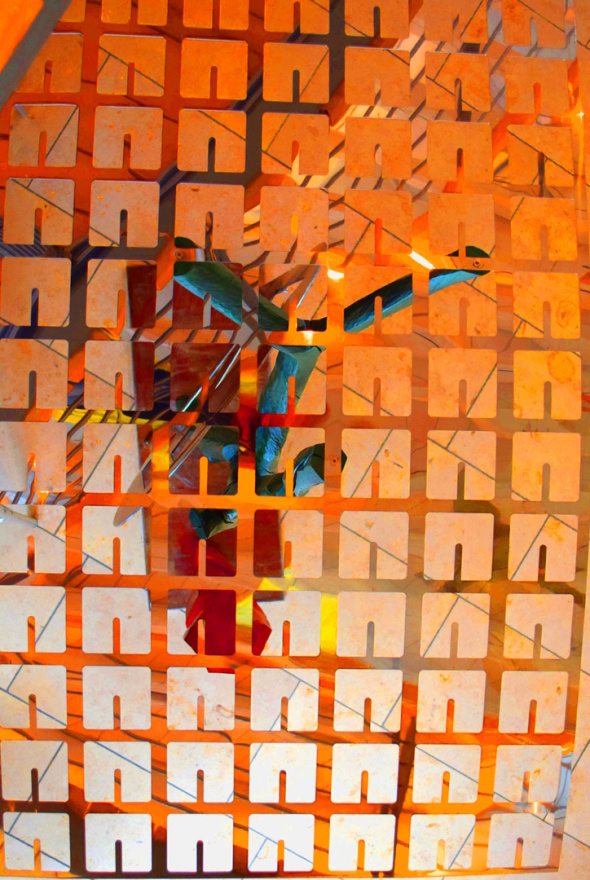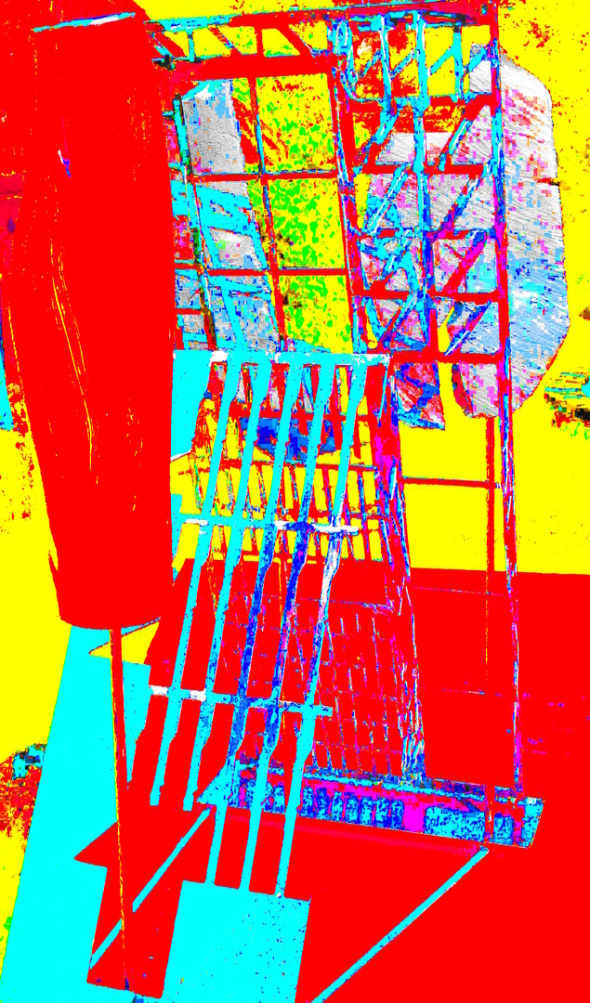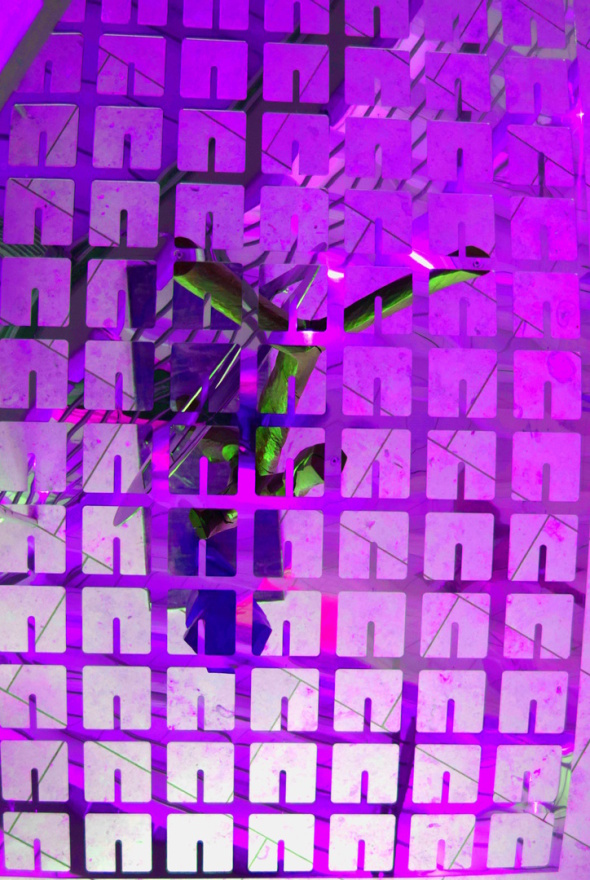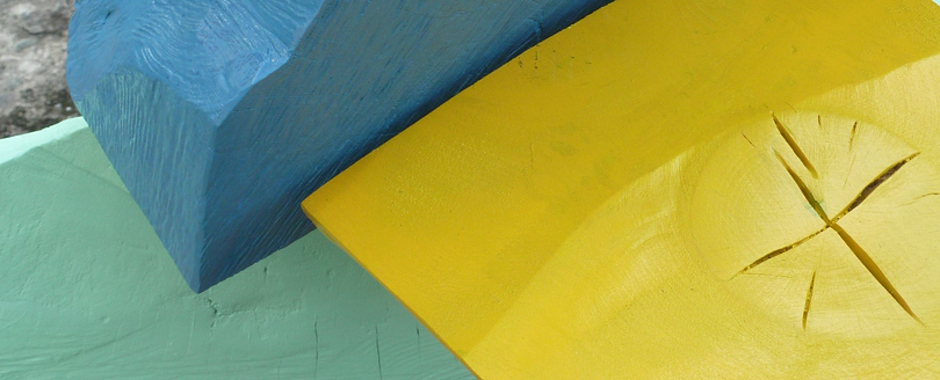
"Lebensschichten - Begegnungen"
Skulptur, Plastik, Installation und Fotografie.
Einzelausstellung, Adelebsen.
Studio Wasserscheune,
13. Juli - 1. November 2014
Am 30. und 31. August wurden die Kunstwerke im Rahmen des "Offenen Ateliers" gezeigt, das im Studio Wasserscheune Künstlerinnen und Künstler aus dem Landkreis Göttingen präsentierte.
Berthold Grzywatz
Lebensschichten - Begegnungen
In der alltäglichen Erfahrung – mithin im Leben – ist das Ich Systemen unüberschaubarer Komplexität konfrontiert, die Erkennen oder Verstehen allenfalls in Teilen zulässt. Gemachte Erfahrungen suchen nach Einordnung, nach Überprüfung und nach Austausch in der sozialen Praxis. Die soziale Umwelt ist der Ort der Bestimmung von Individualität, von Selbstbestimmung; die Verwirklichung der eigenen Besonderheit vollzieht sich dabei stets unter der Bedingung, Gemeinschaft und damit die Freiheit anderer anzuerkennen. In der Aktualität einer wirklichen Gemeinschaft erfährt sich das Individuum als Person.
Selbstbestimmung zu realisieren, heißt auch, sich der Vergangenheit zu stellen, eine nicht zu negierende Geschichte zu akzeptieren und die Erfahrung als Selbst im Dialog zu einem anderen Selbst zu machen. Die Basis gemeinsamen Handelns in der Sozietät zeigt sich dabei in den sittlichen Normen, die der Mensch im lebensgeschichtlichen Prozess vorfindet. Lebensform, gesellschaftliche Regeln sind in allen Lebensschichten gegenwärtig, binden Entscheidungen. Selbst in der äußersten Daseinserfahrung, der Liebe, der bewussten und totalen Selbsterfahrung des sich in seiner geschichtlichen Gestaltung selbst aufgegebenen Menschen, ist das Ich diesen Regeln als Vorentscheidungen konfrontiert. Gegenüber sozialem Konformitätsdruck, gegenüber Gewissheit, Eifer und Absolutheit bewahrt sich das Individuum durch Skepsis ebenso wie es im Verhältnis zur Gesellschaft eine notwendige Differenz sucht.
Der zentrale Aspekt meiner Arbeiten bezieht sich auf das Individuum, auf seine Entdeckung in vielfältigen Begegnungen, auf das Aufschließen von Lebensschichten im Gewirr der äußeren Erscheinungen, in seinen Bewegungen auf den Ebenen des Öffentlichen und Privaten, in Beziehungsgeflechten und emotionalen Verästelungen. Inneres und Äußeres soll in seiner gegenseitigen Durchdringung begriffen und erfahrbar gemacht werden. Das Fragmentarische von Biografien ist zu entdecken: Bindungen, Einbindungen, Anforderungen, Erwartungen und Rollen, aber auch Verweigerungen, Rückzüge, Fluchten, Träume, Wünsche und Hoffnungen.
Die Bildwerke streben keine Erzählung im Sinne linearer Prozesse an, die durch tradierte Wiederholungen und Brüche gekennzeichnet sind. Vielmehr geht es um Abstraktion, um Strukturen und Fragmente, um Relationen und Konstellationen, die auf Typisches bzw. Allgemeines und Expression abzielen. Die Kunst erscheint insofern als surrealer, emotionaler Raum. Sie geht allerdings nicht mit Verschleierung oder hermetischer Abriegelung einher, sondern vielschichtig, anspielungsreich, anhaltend verunsichernd, provokativ anregend und spannungsgeladen bildet sie den Ausgangspunkt für einen dynamischen Reflexionsprozess.
Dieser Reflexionsprozess beinhaltet nicht die Erschließung eines bestimmten Inhalts oder das Dechiffrieren und Identifizieren von Motiven. Als autonomes Tun ist er an den Betrachter gebunden, an dessen individuelles Sehen und Denken. Insofern gibt es keinen Gegensatz zwischen Fantasie, Deutungswillen und tatsächlicher Anschauung. Dennoch entfaltet sich der inhaltliche Erkenntnisprozess in Bindung an das Werk und in der Regel gibt der Titel einen Ausgangspunkt der Reflexion. Durch abstrakte Strukturen, durch Fragmente und Details des Realen, die Symbole bzw. Zeichen des Zusammenhangs von Welt präsentieren und dessen Sehen befördern.
II
Die verwandten Materialien sollen in ihrer Anordnung und in ihrer Eigenwirkung Spannungen, Gegensätze oder Widersprüche sichtbar machen. Daher gibt es keine flächendeckenden Glättungen oder eine aus sich selbst heraus sprechende Materialästhetik. Stets wird in das Material eingegriffen, gar bewusst Beschädigungen herbeigeführt, um sich dem nicht messbaren Lebensprozess symbolisch anzunähern.
Wenn Holz, Stein und Metall sich in der Skulptur oder im Objekt begegnen, dann treffen differierende Formen und Formprinzipien aufeinander: Organisches und Technisch-Industrielles, Gewachsenes und Lineares, Brüchiges und Geschlossenes. Die Materialien treten in ein Wechselspiel zwischen Leichtigkeit und Schwere, zwischen Licht und Dunkelheit, zwischen Auflösung und Blockhaftigkeit. So spiegelt sich in den Materialien das Verhältnis von Natur und technisch-industrieller Zivilisation.
Natur wird hier nicht als Ort mythischer Überhöhung, als Ort der Gegenutopie begriffen; ihr wird auch nicht eine spirituelle Wirkung, etwa durch ihre Leere und Unberührtheit zugesprochen, sondern sie wird als offener Raum gesehen, der neben der Begegnung mit der Formenvielfalt eben auch Reduktion und Konzentration erfahrbar und damit dem Menschen Wahrnehmungen außerhalb der verdinglichten Welt zugänglich macht.
Vielleicht ist hier an Kant zu erinnern, nach dem es in der Naturerfahrung nicht um die Gunst geht, die die Natur dem Menschen zeigt, sondern um die Gunst, mit der das Ich die Natur aufnimmt. Der Mensch steht zwar in Abhängigkeit von der Natur, ist aber ebenso frei wie autonom in ihrer Anschauung. Die Naturwahrnehmung bietet für den Menschen Weltorientierung, ihre Wunden zeigen die eigenen Beschädigungen des Menschen, was keinesfalls Instrumentalisierung einschließt. Die Natur ist kein Gesprächspartner des Menschen, eine „Solidarität zwischen Natürlichem und Menschlichem“ kaum denkbar, die Abhängigkeit gebietet indes notwendiges Handeln für Entwurf und Sicherung von Zukunft.
Wenn die Natur, wie Kant meint, das Vermögen besitzt, ästhetisch-zweckmäßig zu bilden, dann charakterisiert sie sich als Ort, an dem die Fantasie Impulse empfängt. Die Begegnung mit ihren Formen bleibt aber an das Sehen gebunden, das gleichsam zum Material für den künstlerischen Prozess wird.
Nun ist die Natur, die uns etwa im europäischen Alltag begegnet, nicht der unberührte Raum, den Künstler des 19. und 20. Jahrhunderts mit langen Reisen gesucht und sich dabei immer weiter in entlegenere Orte gewagt haben, vielmehr ist es die Landschaft, an die der Mensch Hand angelegt hat. Ein gehegter Garten, selbst dort noch, wo der Wildnis ein Stück Raum gelassen wird. Die industrielle Welt hat die Landschaft nach ihren Erfordernissen, Notwendigkeiten und Bedürfnissen geprägt, damit wird die Natur nicht beherrschbar, aber das Ich wandelt in einem Raum jenseits der Unschuld. An den Bruchstellen zwischen urbanem und ländlichem Raum zeigt sich am deutlichsten, wie Ordnung sich fortsetzt, wie Raster und Strukturen Agglomerationen schaffen, die ohne Eingriffe nicht denkbar wären und möglicherweise auch nur in dieser Form für den gegenwärtigen Menschen annehmbar sind.
Industrie und Technik haben neue Seh- und Wahrnehmungsweisen eröffnet. So werden durch Bewegung dynamische Raum- und Zeiterlebnisse möglich, das elektrische Licht sorgt durch die Regulierbarkeit von Lichtstärke und Farbkomposition für die Beeinflussung von Stimmungen, das laufende Bild lässt durch Montage, Addition und diskontinuierliche Produktion die rhythmische Gestaltung von Zeitabläufen zu. Die Reduktion, Zergliederung und Beschleunigung der Darstellung werden zu einer neuen ästhetischen Erfahrung.
Das industrielle System ist von der Kunst immer mit kritischen Vorbehalten betrachtet worden. Das gilt nicht zuletzt für den technologischen Wandel und die innovative Produktivität der Technik. Während die Natur für manchen Künstler zum inneren Gesprächspartner wird, deren Formen die plastische Fantasie anregen und die als Teil einer überzeitlichen Existenz zu begreifen ist, gerät das industrielle System zum fragwürdigen Gebilde technisierter Lebenswelten, die eine Gesellschaft des Konsums und des Wegwerfens etablierte.
Die marxistisch orientierte Kritik insbesondere wird bis heute nicht müde, die vom Industrialismus erzeugte namenlose Massengesellschaft anzuprangern, deren maschinelle Gleichförmigkeit zur Reduktion der Persönlichkeitsprofile führt und ein menschliches Ich ohne innere Kohärenz erzeugt. Selbst dort, wo das System die Emanzipation von überkommenen Verhältnissen fördert und Möglichkeiten selbstbewusster Individualität schafft, bleibt sie aus dieser Sicht nur Fassade. Dahinter wird eine einebnende, mechanische Grundstruktur des menschlichen Seins sichtbar. Dem negativen Bild vom industriellen System als einer „technomorphen Entseelungsmaschinerie“ steht in rechtfertigender Weise eine nivellierende Fortschrittsromantik gegenüber, die sich der Technik und den Methoden der Produktion unterwarf.
Die Kunst, die Antworten auf das industrielle System suchte, besann sich auf die Erneuerung von Kunst und Leben. Ästhetisch mag sie eine Zeit lang bestrebt gewesen sein, die individuell motivierte Komposition zu überwinden, indem sie eine auf die Beherrschung des Raums ruhende Konstruktion anstrebte. Diese sollte die Einheit der Form, die Egalität der Teile und die Aufgabe von Subordinationsprinzipien erzwingen. Letztlich sorgte aber die Autonomie künstlerischer Kreativität für Heterogenität, Komplexität und Pluralismus, schließlich auch für Erweiterungen, Entgrenzungen bzw. Grenzüberschreitungen in der Kunst, ohne dass sie sich dabei von der sozialen Wirklichkeit abkoppelte.
Die digitale Technologie schließlich ebnete neuen Konzepten von Raum und Zeit den Weg und damit sowohl neuen Wahrnehmungen des Menschen als auch dessen veränderten Sichtweisen von Welt, Umwelt, Politik und Gesellschaft. Mit der Globalität von Kommunikation und Information ist das Ich nicht mehr an die Statik des individuellen Ortes gebunden, während die Nichtlinearität von Zeit unmittelbar erfahren werden kann. Dennoch bleibt das Sehen als eine direkte örtliche Auseinandersetzung mit Objekten in Raum und Zeit bestehen. Per Kirkeby hat einmal das künstlerische Sehen als ein Schauen definiert, das über Alltag und Wissenschaft hinaus ein intensives, wenn nicht gar „reines“ Sehen darstellt, geprägt durch die besondere, eben nicht allgemeine Position des Künstlers, der stets von der Suche gefordert ist, tatsächlich zu sehen, was man sieht. Es ist hier weder an Vision und religiöse Offenbarung noch an Panorama oder eine Vergegenständlichung wissenschaftlichen Sehens gedacht, aber an ein durch die künstlerische Existenz charakterisiertes Erlebnis, das nach Transformation im Werk verlangt.
Das Künstler sein ist für Kirkeby mit einer Außenseiterposition oder Oppositionsstellung verbunden, die ebenso vom Zweifel an der Wirksamkeit von Kunst wie vom Zweifel an der Wirklichkeit des Augenscheins und damit der Realität überhaupt begleitet wird. Das Sehen muss daher als „bewegende Kraft“ verstanden werden, Schichten des Realen aufzuschließen und im Werk zu konkretisieren. Diese Transformation ist selbstredend an das künstlerische Subjekt gebunden und begründet unter Umständen dessen Stellung, sie steht nach der Auffassung von Berthold Grzywatz aber in einem komplexeren Rezeptionsprozess, der Sehen und Sichtbarmachen zu Teilen einer allgemeinen Bewältigung von Realität konstituiert.
III
Da im Kern des Werkverständnisses von Berthold Grzywatz das Herstellen symbolischer und metaphorischer Bilder, das Entwickeln poetischer und erzählerischer Aussagen steht, ist die Wahl der Werkstoffe ein wichtiges Element des künstlerischen Prozesses. Es ist eine Komplexität des Materials gefragt, die diese Zielsetzungen unterstützt. Daher nimmt Holz eine zentrale Stellung in seiner Arbeit ein, denn seine Qualität eröffnet der Gestaltung Freiräume, die auch vom Ton weniger von Stein und Metall gegeben sind. Diese zeigen indessen einerseits eine stoffliche Präsenz durch Gewicht und Stärke der Substanz, so dass sie in ein dynamisches Spannungsverhältnis zu den natürlichen, biomorphen Materialien treten können. Zudem bietet andererseits insbesondere der Stahl die Möglichkeit, flache Formen zu schaffen, Flächen aufzulösen, Linearität und Geometrie als Mittel einzusetzen sowie Offenheit und Transparenz zu erzeugen und die Wahrnehmung von Licht und Raum zu differenzieren. Darüber hinaus lässt dieser Werkstoff durch die Flächenauflösung die handliche Formgebung durch Biegen und Drehen, Strecken und Dehnen zu, während das Schweißen die Produktion von Formen ohne Masse sowie feingliedrige Konstruktionen mit größtmöglicher Offenheit möglich macht.
Berthold Grzywatz nutzt diese Voraussetzungen, um in seinen Werken Gegensätze von offenen und geschlossenen, von linearen und organischen Formen aufzubauen. Gleichzeitig versucht er durch die Arten der Bearbeitung die vorgegebenen Strukturen der Materialien miteinander zu verschränken.
Die Form einer Skulptur entsteht, wie der amerikanische Bildhauer und Konzeptkünstler Robert Morris in seinen „Notes on the Phenomenology of Making“ anmerkte, durch die Bedingungen ihres Produktionsprozesses, so dass der Materialwahl eine herausragende Bedeutung zukommt. Materialeigenschaften und Gestaltung stehen in einem unauflöslichen Zusammenhang; die einem Werkstoff inhärenten Eigenschaften beeinflussen Arbeitsabläufe und Technik der künstlerischen Praxis sowie die intendierten Besonderheiten von Ausdruck und Form. Berthold Grzywatz sieht sich stets durch die Formen und Eigenarten des Materials bzw. der Werksoffe angeregt; sie werden aber nicht als Vorgabe aufgefasst, sondern vielmehr als Ausgangspunkt einer kreativen Konfrontation.
Maschinelle und mechanische Eingriffe strukturieren das Material; dabei geht es nicht um Eingriffe an der Oberfläche, sondern um eine Überlagerung der natürlichen Form durch angelegte formale Strukturen, ohne dass die vorgegebene Form in ihrer Eigenart gänzlich verschwindet. Zudem gebraucht Berthold Grzywatz die durch organische Prozesse hervorgerufenen Beschädigungen des Werkstoffs, etwa durch Risse und Spalten, indem er ihre Wirkung durch Akzentuierung und Verstärkung intensiviert. Mithin auf diese Weise einen vielfältig differenzierten emotionalen Ausdruck hervorruft und innere Strukturen offenlegt, die auf inhaltliche Intentionen abzielen.
Eine weitere Steigerung der emotionalen Wirkung wird durch die Oberflächenbehandlung angestrebt: Öl, Lacke und Farben sollen nicht vom Material der Form ablenken, vielmehr geht es darum, diese schärfer hervorzuheben und eine einnehmende Lebhaftigkeit zu produzieren. Deshalb werden in der Regel keine makellosen Oberflächen geschaffen, die Spuren der Bearbeitung bleiben erhalten, betonen die körperliche Präsenz des Materials. Das betrifft auch den Umgang mit Metallen. Durch maschinelle Eingriffe, beispielsweise mit Hilfe grobkörniger Fächerscheiben, wird die Kühle des Materials aufgebrochen und spannungsreiche emotionale Wirkungen erreicht, die zugleich die Intensität des Materials steigern und durch eine entsprechende Oberflächenbehandlung konserviert werden.
Die flachen, flächigen von Berthold Grzywatz verwandten Metallformen, deren Formenvokabular geometrisch angelegt ist, unter anderem Kreise, Halbkreise, Rechtecke, Quadrate, Rhomben, Dreiecke, Bögen und Linien einschließen, spielen mit den Spannungen von freien und gebundenen Flächen; sie nutzen die Möglichkeiten der Rhythmisierung, die das Material und die technischen Bearbeitungsweisen erlauben. Die Rhythmisierung erfolgt jedoch in den wenigsten Fällen gleichförmig, vielmehr zeigen sich in der Reihung der Formen häufig Brüche – allerdings sind sie nicht spontan wahrzunehmen, sondern erst durch intensives Sehen zu erfassen. Trotz der expressiven Behandlung bewahrt das Material „Metall“ durch seine innere Statik eine gewisse Kühle, vielleicht könnte man auch bildhaft Distanz sagen, die der biomorphen Körperlichkeit des in den Skulpturen verwandten Holzes fremd bleibt.
In ähnlicher Weise nutzt Berthold Grzywatz die spannungsgeladenen Gegensätze der Materialien Stein und Metall. Es ist nicht ohne Reiz, dass er die Möglichkeiten des Metalls zu bewegten, raumgreifenden Konstruktionen und die reflektierende Oberflächenbehandlung durch Polierung einsetzt, um ein kontrastreiches Wechselspiel zwischen Formen und Oberflächen, zwischen Licht und Raum zu schaffen. Mit dem Einsatz von Farben wird die Emotionalität der Anordnungen ebenso verstärkt wie durch den Gebrauch von eigenen Fotografien im skulpturalen Umfeld, die sich thematisch mit Strukturen auseinandersetzen, räumliche Tiefenschichten eröffnet werden.
IV
Die Arbeit mit Gegensätzen in Material, Form und Bearbeitung verweist auf den Bruch bzw. die Verwerfung als konstitutives Gestaltungsprinzip von Berthold Grzywatz. Inhaltlich soll das im Projekt „Lebensschichten – Begegnungen“ deutlich gemacht werden. Wird doch das Leben als Selbst- und Fremderfahrung wahrgenommen. Das Subjekt und sein Erkennen in der Vielfältigkeit von Begegnungskontexten entfalten sich in der sozialen Praxis. Sein Interesse richtet sich auf das Selbst, es muss aber die gesellschaftliche Vermittlung von Einstellungen und Haltungen, von Werten und Normen akzeptieren. Gesellschaftliche und selbst persönliche Bindungen garantieren nicht Nähe und Menschlichkeit, Solidarität und Geborgenheit. Die Erfahrung des Lebens konfrontiert mit Isolation, Egoismus, Misstrauen, Lüge, Zweifel und Automatismen im Handeln, die das Menschliche in Frage stellen oder diesem eine absurde Komik verleihen. Mitunter kommt sich das Ich wie ein Tourist im eigenen Leben vor, dessen Fragmentierung Unsicherheiten hervorrufen, die den Wunsch entstehen lassen, sich mit den Augen anderer sehen zu können. Dennoch gilt es, im Geflecht von Brüchen, Spannungen, Gegensätzen und Widersprüchen nach Individualität und Selbstbestimmung zu suchen.
Berthold Grzywatz
Layers of life - Encounters
In everyday experience - i.e. in life - the ego is confronted with systems of incalculable complexity that allow for recognition or understanding only in part. Made
experiences seek classification, verification and exchange in social practice. The social environment is the place of determination of individuality, of self-determination; the realisation of one's
own particularity always takes place under the condition of recognising community and thus the freedom of others. In the actuality of a real community, the individual experiences himself as a
person.
Realising self-determination also means facing the past, accepting a history that cannot be negated and experiencing oneself as a self in dialogue with another self. The basis for common action in
society is found in the moral norms that the individual finds in the life-historical process. The form of life and social rules are present in all layers of life and bind decisions. Even in the most
extreme experience of existence, love, the conscious and total self-experience of the human being who has given himself up in his historical formation, the ego is confronted with these rules as
preliminary decisions. In the face of social pressure to conform, in the face of certainty, zeal and absoluteness, the individual preserves itself through scepticism just as it seeks a necessary
difference in relation to society.
The central aspect of my work relates to the individual, to his discovery in diverse encounters, to the opening up of layers of life in the tangle of external appearances, in his movements on the
levels of the public and private, in networks of relationships and emotional ramifications. The inner and the outer are to be understood and made tangible in their mutual interpenetration. The
fragmentary nature of biographies is to be discovered: Bonds, ties, demands, expectations and roles, but also refusals, retreats, escapes, dreams, wishes and hopes.
The pictorial works do not strive for a narrative in the sense of linear processes characterised by traditional repetitions and breaks. Rather, it is about abstraction, structures and fragments,
relations and constellations that aim at the typical or the general and expression. In this respect, art appears as a surreal, emotional space. However, it does not go hand in hand with concealment
or hermetic closure, but is multi-layered, allusive, persistently unsettling, provocatively stimulating and charged with tension, forming the starting point for a dynamic process of reflection.
This process of reflection does not involve the development of a specific content or the deciphering and identification of motifs. As an autonomous activity, it is bound to the viewer, to his or her individual seeing and thinking. In this respect, there is no contradiction between fantasy, the will to interpret and actual viewing. Nevertheless, the process of cognition unfolds in relation to the work and, as a rule, the title provides a starting point for reflection. Through abstract structures, through fragments and details of the real, which present symbols or signs of the context of the world and promote its seeing.
II
The materials used are intended to make tensions, contrasts or contradictions visible in their arrangement and in their own effect. Therefore, there is no
comprehensive smoothing or a material aesthetic that speaks for itself. The material is always interfered with, even deliberately damaged, in order to symbolically approach the non-measurable process
of life.
When wood, stone and metal meet in the sculpture or object, different forms and principles of form come together: organic and technical-industrial, grown and linear, fragile and closed. The materials
enter into an interplay between lightness and heaviness, between light and darkness, between dissolution and blockiness. In this way, the relationship between nature and technical-industrial
civilisation is reflected in the materials.
Nature is not understood here as a place of mythical exaltation, as a place of counter-utopia; nor is it ascribed a spiritual effect, for example through its emptiness and untouchedness, but it is
seen as an open space which, in addition to the encounter with the diversity of forms, can also be experienced as reduction and concentration and thus makes perceptions outside the reified world
accessible to man.
Perhaps we should recall Kant here, according to whom the experience of nature is not about the favour that nature shows man, but about the favour with which the I receives nature. Although man is dependent on nature, he is just as free as autonomous in his perception of it. The perception of nature offers man orientation in the world, its wounds show man's own damage, which in no way includes instrumentalisation. Nature is not an interlocutor of man, a "solidarity between the natural and the human" is hardly conceivable, but dependence demands necessary action for designing and securing the future.
If nature, as Kant believes, has the capacity to form aesthetically-purposefully, then it characterises itself as a place where the imagination receives impulses. The
encounter with its forms, however, remains bound to seeing, which becomes, as it were, the material for the artistic process.
Now, nature, which we encounter in everyday life in Europe, for example, is not the untouched space that artists of the 19th and 20th centuries sought with long journeys, venturing further and
further into more remote places; rather, it is the landscape that man has laid his hands on. A cherished garden, even where a bit of space is left to the wilderness. The in-dustrial world has shaped
the landscape according to its requirements, necessities and needs, thus nature does not become controllable, but the I walks in a space beyond innocence. The ruptures between urban and rural space
show most clearly how order is perpetuated, how grids and structures create agglomerations that would be inconceivable without intervention and are possibly only acceptable to contemporary man in
this form.
Industry and technology have opened up new ways of seeing and perceiving. Dynamic spatial and temporal experiences are made possible by movement, electric light can influence moods by regulating the
intensity of light and the position of colours, and the running picture allows the rhythmic shaping of time sequences through montage, addition and discontinuous production. The reduction, dissection
and acceleration of the representation become a new aesthetic experience.
The industrial system has always been viewed with critical reservations by art. This applies not least to technological change and the innovative productivity of
technology. While nature becomes an inner interlocutor for many an artist, whose forms stimulate the plastic imagination and which is to be understood as part of a supra-temporal existence, the
industrial system becomes a questionable construct of technicised living worlds that establish a society of consumption and throwaway.
Marxist-oriented criticism in particular has not tired to this day of denouncing the nameless mass society created by industrialism, whose machine-like uniformity leads to the reduction of
personality profiles and produces a human ego without inner coherence. Even where the system promotes emancipation from outdated conditions and creates opportunities for self-confident individuality,
from this perspective it remains only a façade. Behind it, a levelling, mechanical basic structure of human existence becomes visible. The negative image of the industrial system as a "technomorphic
machine of destruction" is contrasted in a justifying way with a levelling romanticism of progress that submitted to technology and the methods of production.
Art, which sought answers to the industrial system, reflected on the renewal of art and life. Aesthetically, it may have striven for a time to overcome individually motivated composition by striving
for a construction based on the mastery of space. This was supposed to enforce the unity of form, the equality of parts and the abandonment of subordi-nation principles. Ultimately, however, the
autonomy of artistic creativity ensured heterogeneity, complexity and pluralism, and ultimately also expansions, dissolutions or transgressions of boundaries in art, without detaching it from social
reality.
Finally, digital technology paved the way for new concepts of space and time and thus for new perceptions of people as well as their changed views of the world, the
environment, politics and society. With the globality of communication and information, the self is no longer bound to the static of individual place, while the non-linearity of time can be
experienced directly. Nevertheless, seeing remains as a di-rect local engagement with objects in space and time. Per Kirkeby once defined artistic seeing as a looking that goes beyond everyday life
and science and represents an intensive, if not "pure" seeing, characterised by the special, precisely not general position of the artist, who is always challenged by the search to actually see what
one sees. We are not thinking here of vision and religious revelation, nor of panorama or an objectification of scientific seeing, but of an experience characterised by artistic existence that
demands trans-formation in the work.
For Kirkeby, being an artist is associated with an outsider position or opposition, which is accompanied by doubts about the effectiveness of art as well as doubts about the reality of the eye and
thus of reality in general. Seeing must therefore be understood as a "moving power" to open up layers of the real and to concretise them in the work. This transformation is, of course, linked to the
artistic subject and, under certain circumstances, establishes the subject's position, but, according to Berthold Grzywatz, it is part of a more complex process of reception that constitutes seeing
and visualisation as parts of a general coming to terms with reality.
III
Since at the core of Berthold Grzywatz's understanding of his work is the creation of symbolic and metaphorical images, the development of poetic and narrative statements, the choice of materials is
an important element of the artistic process. A complexity of material is required that supports these objectives. Therefore, wood occupies a central position in his work, because its quality opens
up freedom of design, which is also given by clay less by stone and metal. On the one hand, however, these show a material presence through the weight and strength of the substance, so that they can
enter into a dynamic relationship of tension with the natural, biomorphic materials. On the other hand, steel in particular offers the possibility of creating flat forms, dissolving surfaces, using
linearity and geometry as a means of creating openness and transparency and differentiating the perception of light and space. In addition, this material's surface resolution allows for handy shaping
by bending and twisting, stretching and elongating, while welding makes it possible to produce forms without mass as well as delicate constructions with the greatest possible openness.
Berthold Grzywatz uses these preconditions to build up contrasts of open and closed, linear and organic forms in his works. At the same time, he tries to interweave the given structures of the
materials through the ways in which they are worked.
The form of a sculpture is created, as the American sculptor and conceptual artist Robert Morris noted in his "Notes on the Phenomenology of Making", by the conditions of its production process, so
that the choice of material is of outstanding importance. Material properties and design are inextricably linked; the inherent properties of a material influence the work processes and technique of
artistic practice as well as the intended particularities of expression and form. Berthold Grzywatz always sees himself inspired by the forms and peculiarities of the material or the work material;
however, they are not taken as a default, but rather as the starting point of a creative confrontation.
Machine and mechanical interventions structure the material; it is not a question of interventions on the surface, but rather of a superimposition of natural form by
applied formal structures, without the given form completely disappearing in its own way. In addition, Berthold Grzywatz uses the damage to the material caused by organic processes, such as cracks
and fissures, by intensifying their effect through accentuation and reinforcement. In this way, he evokes a multifaceted, differentiated emotional expression and reveals inner structures that are
aimed at content-related intentions.
A further increase of the emotional effect is aimed at through the surface treatment: Oil, varnish and paint are not intended to distract from the material of the form, but rather to bring it into
sharper focus and produce an engaging vividness. Therefore, as a rule, no flawless surfaces are created; the traces of the treatment remain, emphasising the physical presence of the material. This
also applies to the handling of metals. Through mechanical interventions, for example with the help of coarse-grained fan discs, the coolness of the material is broken up and exciting emotional
effects are achieved, which at the same time increase the intensity of the material and are preserved through an appropriate surface treatment.
The flat, two-dimensional metal forms used by Berthold Grzywatz, whose vocabulary of forms is geometrical and includes circles, semicircles, rectangles, squares,
rhombuses, triangles, arcs and lines, play with the tensions between free and bound surfaces; they use the possibilities of rhythmisation that the material and the technical methods of working allow.
The rhythm, however, is rarely uniform; rather, breaks often appear in the sequence of forms - although they are not perceived spontaneously, but can only be grasped through intensive viewing.
Despite the expressive treatment, the material "metal" retains a certain coolness through its inner static, perhaps one could also figuratively say distance, which remains alien to the biomorphic
physicality of the wood used in the sculptures.
In a similar way, Berthold Grzywatz uses the tense contrasts of the materials stone and metal. It is not without charm that he uses the possibilities of metal to create moving, expansive
constructions and the reflective surface treatment through polishing to create a contrasting interplay between forms and surfaces, between light and space. The use of colour intensifies the
emotionality of the arrangements, as does the use of the artist's own photographs in the sculptural environment, which thematically deal with structures, opening up spatial layers of depth
.
IV
The work with contrasts in material, form and processing refers to the rupture or the dislocation as a constitutive design principle of Berthold Grzywatz. In terms of content, this is to be made clear in the project "Layers of Life - Encounters". After all, life is perceived as an experience of the self and of others. The subject and its recognition in the diversity of encounter contexts unfold in social practice. Its interest is directed towards the self, but it must accept the social mediation of attitudes, values and norms. Social and even personal ties do not guarantee closeness and humanity, solidarity and security. The experience of life confronts us with isola-tion, egoism, mistrust, lies, doubt and automatisms in action that question the human or lend it an absurd comedy. Sometimes the ego feels like a tourist in its own life, whose fragmentation causes insecurities that give rise to the desire to be able to see oneself through the eyes of others. Nevertheless, it is important to search for individuality and self-determination in the web of fractures, tensions, contrasts and contradictions.
